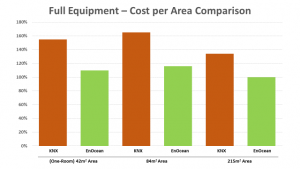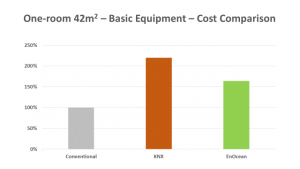Wired or Wireless Technology: Which is Better for a Connected Home?
By Julia Winkler (B.Eng.), Prof. Dr. Michael Kroedel, Marketa Sidlikova (M.Sc. in Finance)
Smart Home is “in”. Networking your own four walls is becoming easier and more user-friendly than ever with the increasing number of corresponding end devices and professional system solutions. The hardware alone however does not make a home intelligent. It depends on the type of networking: wired or wireless. A new study by the Technical University of Applied Sciences Rosenheim compares the common smart home standards KNX and EnOcean in different living scenarios.
We spend around 90 percent of our life in buildings, a good part of it in our own four walls. Regardless of whether in an apartment or in your own villa: Smart Homes increase the comfort and safety of their residents. They ensure more efficient use of energy, save costs and are therefore an absolute “must” when it comes to climate efficiency. So it’s no wonder that the trend towards intelligent homes is continuing, as a look at the smart home market shows. According to Statista, penetration of smart home products will increase from 41,6% to 85,7% in 2025. This corresponds to an annual sales growth of 11.8 percent.
What is a Smart Home?
Smart Home means professional building automation for your home. Technical devices of various types are connected in a network, they interact and can be controlled from the outside. For this purpose, the information from the network is communicated by means of a central control unit. Alternative terms are smart living, connected home, home automation or eHome. Automation solutions especially for seniors are also referred to as modern ambient assisted living (AAL).
How Does a Smart Home Work?
A professional smart home is an intelligent system that networks individual products (sensors and actuators). This forms the technical basis for automated control and flexible operating options for building technology in various areas. In addition to lighting, shading and heating/air conditioning/ventilation, the most important are security, entertainment electronics and information technology/telecommunications. Sometimes charging stations for electric cars are also integrated into the smart home system. Individual intelligent products such as voice assistants or smart meters, on the other hand, do not yet make a smart home.
Spoiled for Choice: Wired or Wireless?
Digital networking is a prerequisite for the smart home. It is this that enables the smooth communication of the individual components in apartments or residential buildings.
This can be done in two completely different ways, with or without wireless technology. In addition to proprietary solutions from individual manufacturers, there are also open standards for both variants. KNX (wired) and EnOcean (wireless) are each representative in their segment.
KNX (Konnex) is a widely used wired bus system for building automation. As a further development of the EIB (European Installation Bus), KNX is an open, manufacturer-independent standard that is supported by a large number of manufacturers. As a standardized standard, KNX leaves a lot of scope for design and is considered to be particularly secure.
EnOcean was defined in March 2012 by the International Electrotechnical Commission (IEC) as a global wireless standard (ISO / IEC 14543-3-10) for decentralized building automation. In the meantime, more than a million buildings have such radio networks. The EnOcean ecosystem of self-powered wireless sensor solutions currently consists of 5,000 product variants based on 1,500 basic products. The products can be combined with one another using standardized interoperable sensor profiles.
Wired or Wireless: Who is Ahead in the Smart Home?
The study by Julia Winkler and Prof. Dr. Michael Krödel compares smart homes of different sizes based on KNX or EnOcean technology in two equipment variants with regard to costs, sustainability and health and well-being. In both cases, a conventional building without intelligent networking serves as a guide.
In detail it concerns:
- A one-room studio apartment (450 sq. ft.) with a total of 33 or 42 products (basic or full equipment)
- A two-bedroom apartment (900 sq. ft.) and a total of 70 or 89 products
- A single-family house (2300 sq. ft.) and a total of 162 or 186 products
The equipment in conventional buildings is based on the international standard DIN 18015-RAL-RG678 for the installation of electrical systems in residential buildings (three-star comfort equipment). The differentiation of the smart home variants is based on internal university research results. The basic equipment includes typical entry-level functions for comfort, safety and energy-saving. In addition to the basics, the full equipment includes additional functions such as brightness and presence detectors, a central switch for heating control, as well as weather stations and the complete security package.
The cost calculation for the individual equipment options is based on the calculation aid for electrical and information technology trades (KFE, as of 2020) as well as the current publically available product catalogues from representative providers such as Hager (for KNX) and Eltako (for EnOcean).
Invest in Smart Living
A comparison of the conventional “dumb” installation with the smart equipment reveals an unsurprising picture: Smart costs initially more. According to the study, the surcharge for electrical installation is between 64% in a one-room studio apartment with basic equipment based on EnOcean and 385% in a fully equipped two-bedroom apartment based on KNX.
GRAPHICS

Caption: Example of full equipment in various home types. The wired smart home requires 30% more total initial investment than the wireless solution.

Caption: Example of basic equipment in a one-room apartment: The smart versions are initially more expensive than the conventional equipment. The wired smart home requires the highest total initial investment.
The smart additional functions make living space initially more expensive. In the medium and long term, however, the investment is well worthwhile. Because immaterially, a higher quality of living has an impact on comfort and safety from day one. And in concrete terms, up to 10 percent of heating energy costs can be saved through intelligent heating. A significant potential when you consider that heating accounts for around 60 percent of the energy consumption of private households and is mostly heated continuously, especially in winter.
Wired or Wireless Technology in the Smart Home?
When comparing the smart home variants “wired” (KNX) or “wireless” (EnOcean), wireless is significantly lower in terms of costs. With comparable functionality, the difference is 20 to 30 percent. This applies to all buildings and equipment variants. This is due to the higher expense of cabling and the cost of the wired devices and their installation.
Switches and sensors based on EnOcean do not need cables. They can be simply attached and implemented as required – a big plus in terms of flexibility, for example when retrofitting or converting. The use of fewer cables also saves PVC – according to the study, up to 8.5 kg per smart home – and improves the overall environmental balance of the construction project.
What about Electro Smog in Wireless Smart Homes?
The radiation exposure is 700 times lower than that of WLAN or Bluetooth connections and 1.6 million times lower than conventional smartphones. The so-called SAR value is decisive for this. SAR stands for Specific Absorption Rate and indicates the maximum amount of transmission power the human body can absorb.
Conclusion
The intelligently networked home initially costs more. But these investments are well worthwhile in terms of the intangible gain in comfort and safety as well as lower energy costs. The installation costs of the wireless smart home are up to one-third less than the wired version. Wireless also scores in terms of flexibility and environmental protection.
Sources:
https://www.buildinggreen.com/blog/we-spend-90-our-time-indoors-says-who
https://ec.europa.eu/commission/presscorner/detail/en/IP_03_1278
https://de.statista.com/outlook/dmo/smart-home/deutschland
https://www.statista.com/outlook/dmo/smart-home/united-kingdom
Winkler, J. (2021). Comparison – Building Automation: With and Without Wireless Technology. Study performed as part of Bachelor Thesis by Julia Winkler at the Technical University of Applied Sciences Rosenheim. English translation and adaption by Marketa Sidlikova.
Download the full article: https://www.enocean-alliance.org/wp-content/uploads/2021/08/Wired-vs-Wireless-Smart-Home.pdf



 English
English  Deutsch
Deutsch  简体中文
简体中文  Français
Français  Italiano
Italiano 
